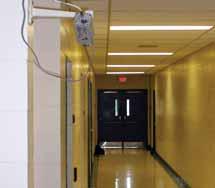
4 minute read
CCTV in our schools –Does it provide a clear picture for security?
BY WILLIAM A. VANRYSWYK
On May 23rd, 2007, Jordan Manners was gunned down in a Toronto District School at 2:30 in the afternoon.
On September 13th, 2006, Kimveer Gill shot and killed one person and injured nineteen others before taking his own life at Dawson College in Montreal.
On December 6th,1989, Marc Lépine, armed with a legally obtained semi-automatic rifle and a hunting knife, shot twenty-eight people, killing fourteen (all of them women) and injuring the other fourteen before killing himself at the École Polytechnique in Montreal.
Exterior camera mounted on a Winnipeg school.


I could continue with other Canadian examples but the gruesome point has been made - shootings and stabbings in Canadian schools have become a reality. The question is, what are we prepared to do about it?
Usually, the first solution brought to the table is to ‘install a CCTV (Closed Circuit Television) system’. Most often these recommendations come from those who know little about CCTV, its benefits and its drawbacks. Don’t get me wrong –I am a strong advocate of CCTV – but only when it is used for the appropriate reasons and when properly supported.
So how can we best use CCTV in our schools? The first question one must ask is, “what am I trying to achieve with the installation of these cameras?” If you are using cameras in hopes to deter violent crimes, you may be wasting your money. There are many studies that indicate CCTV has little bearing on deterring crimes such as robbery, murder and sexual assault. If, on the other hand, you are implementing a CCTV system to monitor staff performance or to help supervise students, respect for privacy and management of staff may come under scrutiny.
There is no doubt in my mind that the
From left to right: accessible on/off switch; antiquated VHS-CCTV application; improper camera placement (hockey stick height) and cabling.



installation of a properly supported CCTV system will have a positive impact on deterring criminal occurrences such as vandalism, theft, break and enter, arson, and in some cases bullying. A well placed camera can minimize areas of concealment and provide surveillance for areas that are perceived as unsafe. At times, just the presence of cameras can instill a sense of safety and security for staff and students.
According to an article recently written for the Canadian Security Magazine, Winnipeg’s John Taylor Collegiate states that their students have confidence and a sense of accountability in the newly installed CCTV system. Cameras can assist emergency response teams to view certain areas of the school prior to an Immediate Action Rapid Deployment (IARD). And of course, probably the best attribute to a CCTV system is the ability to use it as an investigative tool. The advantage that schools have over public forums is that often the perpetrator is a student and can be identified through footage.
Once the need for a CCTV system is established, what are the next steps? This is where many schools fail to do their homework. Installing a CCTV system is not as easy as calling your local electrician and having a few cameras mounted. An analysis needs to be conducted by a security professional in order to understand which type of system would best suit the physical structure of the school, and what form of support is required to manage it.
Will the system be based on IP technology? Will it be required to install coax cable throughout the school? How many cameras will be required to capture high risk areas, and more specifically, what type? What type of lens will best suit each camera location? How much storage of data will be required and for how long? Who will be responsible for developing policies and procedures prior to the installation of the system? This is not a ‘cookie cutter’ solution, but unfortunately, many fall victim to a ‘one size fits all’ sales pitch in an earnest effort to elevate the level of security as quickly as possible.
What these, and similar questions, demonstrate, is that the process of implementing a CCTV system appropriate for your school’s basic and unique requirements, physical design and community environment requires an in-depth investigation and professional input.
To answer many of these questions, the first step in an analysis is to conduct a thorough security audit to establish the true ‘needs’ of the school from those that may be perceived. Don’t rush into implementing a CCTV system that may need to be replaced, upgraded or removed because it does not benefit your students, staff and school community.
There is no doubt that implementing a proper CCTV system in any school will have its advantages to reducing crime and creating a safer environment; however, it is an essential activity that needs to be undertaken with great care and with informed guidance.
William VanRyswyk is the President & CEO of an independent, Canadian-owned security consulting firm that provides security consulting and training services to universities, colleges and various school boards across Canada. ❏











